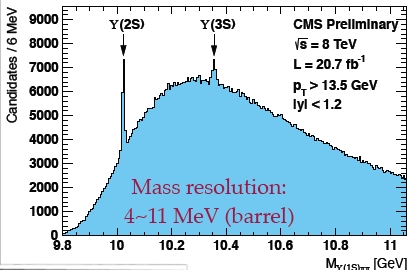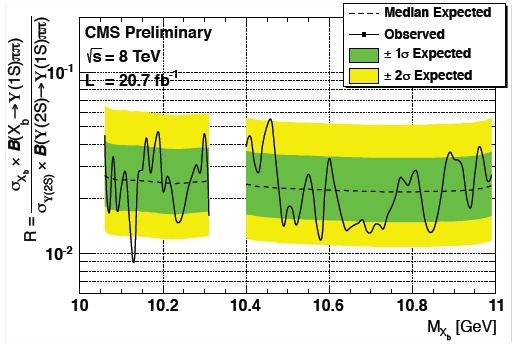Do you remember the X(3872) ? This is a hadron containing charm and anticharm quarks, which was observed to decay into a J/Psi meson, a positive, and a negative pion. When it was discovered, by the Belle experiment in 2003, the X caused a lot of interest among spectroscopists, because it is an "exotic" charmonium state: its nature is not totally clear, as it might be interpreted as a "molecule" of two charmed mesons loosely bound together. Or maybe a four-quark system ? Or just conventional charmonium, a bit at odds with the expected set of spin-parity states but otherwise just a honest meson ?
(I should add that the X discovery also caused some nerve wrecks within the CDF experiment, when it was discovered that a convincing X signal had been present in CDF data earlier on, and had not been claimed).
Anyway, ten years after its discovery the X remains a controversial object, but a well studied one - the CMS experiment, for example, has a clean sample of 12,000 X decays. One thing is clear, though: if two charm quark can do it, there is no apparent reason why two bottom quarks should not do it. In physics whatever is not forbidden is mandatory, so if there is no hard rule preventing the existence of a heavy version of the X, call it X_b, that can be obtained by exchanging charms with bottoms, then that particle should exist.
CMS sought for a signal of such a counterpart of the X in 20 inverse femtobarns of collisions between protons at 8 TeV center of mass. Despite the precise knowledge of the X(3872) mass, theoreticians do not agree on the precise mass that the new state X_b should have; it's not just like "subtract twice the charm mass and add back twice the bottom mass", because of several reasons... First of all, we don't know well the masses of these quarks; second, they are not even well defined, since they depend on the energy scale at which they are studied; third, the interaction energy of the quarks in the mesons modifies the mass of the particle, so either one knows exactly what's inside, or one can only live with a ballpark estimate: "10-11 GeV".
At that mass, one may expect a sizable fraction of these particles would decay into a Upsilon(1S) meson and two pions, mimicking the X decay (the Upsilon is just the counterpart of the J/Psi, when in place of a charm-anticharm pair you put a bottom-antibottom one). So that was the CMS strategy: reconstruct a Upsilon, add two pions coming from the same vertex, and see if a mass bump sticks out of a continuum background.
Such a search is simplified by the fact that one gets two easy "reference signals": the two heavier brothers of the Upsilon(1S), called (2S) and (3S) respectively, do sometimes decay into a Upsilon(1S) plus two pions. The Upsilon(1S) then produces a clean signature when it in turn decays into a muon pair. The four charged particles are well measured and the invariant mass of the four-body system can be reconstructed with very nice resolution, as the figure below demonstrates: you can spot by eye the (2S) and (3S) signals. Do you see anything else sticking out ?

Right, nothing. Unfortunately, no evident additional bump is observed. The search is performed in a wide mass range (excluding the mass windows occupied by the Y(2S) and Y(3S), which would hide a signal), so a large "trials factor" need to be accounted for. The largest fluctuation is a 2.6-sigmaish one (at 10.46 GeV), but once one accounts for the multiplicity of places where it could have arisen by chance, that results in a less-than-one-sigma effect. CMS can therefore only set an upper limit on the rate of production times branching fraction into Upsilon(1S) plus two pions for this hypothetical new particle. The limit is shown below.

I think these searches are quite fun and interesting. The fun is evident: you are dealing with real decays, which you can see - the Upsilon resonances, for instances, are a pleasure to observe. The interest is also clear: we know way too little of the dynamics of bound quark states, so every new study in this sector is not time ill spent!



Comments